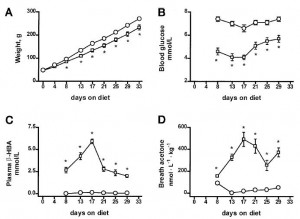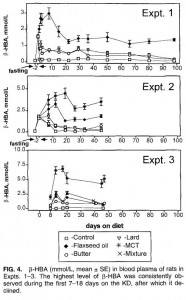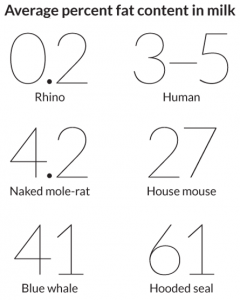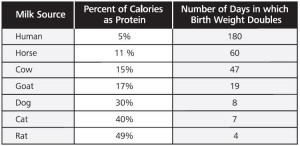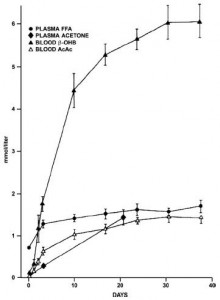This is where the magic happens.
Rat pups, fed a flaxseed oil-based ketogenic diet from weaning onward – note the drop-off in ketones after 2 weeks (Likhodii et al., 2002):
What happened on day 17?
Patient history: these rats have been “low carb” their whole lives.
Side note: flaxseed oil is very ketogenic! (Likhodii et al., 2000):
Flaxseed oil-based ketogenic diet produced higher ketones than 48h fasting; the same can’t be said for butter or lard. PUFAs in general are more ketogenic than saturated fats in humans, too (eg, Fuehrlein et al., 2004):

Crisco keto (adult rats) (Rho et al., 1999):
suspect those two rogue peaks were experiment days…
At this point, please just note the stunning consistency in the drop-off of ketones.
Experiment 1 & 2 (above) are adult rats; they went through a period of high carb chow dieting, unlike experiment 3 and the rats in the first study, who were weaned onto ketogenic diets. Still same phenomenon: ~few weeks after initiation of ketogenic diet = breakpoint; ketones decline.
Ketoadaptation: why do ketone levels decline? This happened in both rat studies above, Phinney 1983, and in many “n=1” practitioners.
Possible explanation 1 (ketoadaptation): rat milk is kind of like a low carb diet; high in fat, but not low enough in other stuff to be ketogenic.
-Hooded seal milk is practically heavy cream: imagine the amount of suction pups must need to apply. Poor mom, that’s gotta hurt; fortunately, lactation only lasts 4 days.
-Rat milk is super-high protein.
Therefore, weaning to the flaxseed oil-based keto diet is what really initiates ketoadaptation… which seems to take 2-3 weeks (judging by the decline in ketones [this is explained further below]).
Possible explanation 2 (physiological insulin resistance): free fatty acids released faster then they’re burned, accumulate in skeletal muscle, induce mild physiological insulin resistance. This is evidenced by glucose levels trending upward at this time, and the modest increase in insulin still works in adipocytes just fine.
These aren’t mutually exclusive:
Phase 1: first few days of ketosis, rapid increase in ketones & fatty acids, and drop in glucose; may share some features in common with starvation.
Carbohydrate restriction is not starvation. Just google “urea cycle” if you don’t understand the differences; it’s regulated completely differently in both contexts…
Phase 2: 2-3 weeks in these studies, may take longer in humans (ie, 3-4 weeks). Mitochondria are proliferating. Ketones high.
Phase 3: ketoadapted + physiological insulin resistance; circadian ketosis: ketones decline, reach steady state at a lower level. . In early starvation, skeletal muscle runs on ketones as they become increasingly available, but then switches to fatty acids, which is how ketones are able to reach > 6 mM in this context.
Theory: during nutritional ketosis, muscle doesn’t make this switch, and the decline in ketones occurs because that’s how long it takes for muscle mitochondria to catch up. KETOADAPTATION! Ketones in starvation usually reach > 3x higher than those in nutritional ketosis (part of this is because non-fat fuels are more abundant when you’re eating [eg, dietary protein] than when you’re not [eg, muscle protein]).
Starvation:
Muscle ketone use would also be in agreement with increased power output and capacity for high intensity physical performance once ketoadapted. Ie, ketonez are the super-fuel (cite any paper by Richard Veech).
From weeks 3 to 4, ketones drop from 2.82 mM to 1.58 mM… ketoadaptation or physiological insulin resistance alone might explain why they don’t continue to rise, but not necessarily why they decline; that part of the equation may require both.
Recap (part speculation): during starvation, muscle starts on ketones but then switches to fatty acids, in part, to prevent wasting and spare ketones for the brain. This is how ketones get so high, and it doesn’t happen when you’re eating [keto]. While on a ketogenic diet, muscle uses ketones and does so increasingly so after ketoadaptation, when mitochondrial capacity is up to snuff <– that’s the speculative bit; but it could explain: 1) why ketones routinely decline in humans & rodents after ‘ketoadaptation;’ and 2) how physical performance is restored (ie, Veech).
If you like what I do and want to support it, check out my Patreon campaign!
UPDATED Affiliate links: still looking for a pair of hot blue blockers? Carbonshade and TrueDark are offering 15% off with the coupon code LAGAKOS and Spectra479 is offering 15% off HERE.
If you have no idea what I’m talking about, read this then this.
20% off some delish stocks and broths from Kettle and Fire HERE.
If you want the benefits of ‘shrooms but don’t like eating them, Real Mushrooms makes great extracts. 10% off with coupon code LAGAKOS. I recommend Lion’s Mane for the brain and Reishi for everything else.
Join Earn.com with this link.

